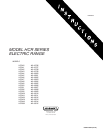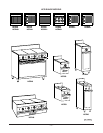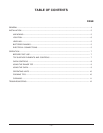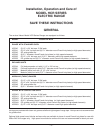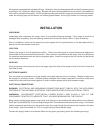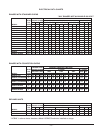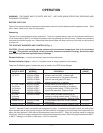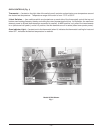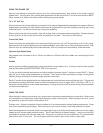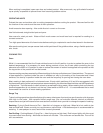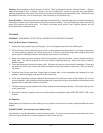
– 11 –
CLEANING
WARNING: DISCONNECT ELECTRICAL POWER SUPPLY BEFORE CLEANING.
Daily (Or More Often If Necessary)
1. Empty and clean grease trays and troughs. Do not line grease tray with heat-reflecting foil.
2. While still warm, wipe surface tops with a cloth or other grease absorbing material (or scrape if necessary)
to remove spillover, grease, etc., before they burn in. A crust on top of the range looks unsightly and slows
down speed of cooking because it reduces the flow of heat to the utensil.
3. Keep oven clean to prevent smoking. Never allow grease or fat to accumulate. Use an enamel cleaner or
damp cloth. The vitrious enamel on the oven interiors simplifies cleaning. Steel wool may be used for
stubborn spots.
4. Clean stainless steel fronts with a damp cloth. Stubborn soil may be removed with a detergent. Rinse and
dry with a soft clean cloth. Never use abrasive cleaners, sharp instruments or steel wool. They can scratch
the finish.
5. Porcelain oven linings and door linings may be cleaned with a cloth dampened with detergent or oven
cleaner. Rinse thoroughly and dry with a soft clean cloth.
6. Clean oven inspection and light window in the same manner as the liner or with a mild abrasive. Do not use
scouring powder ; it will scratch and fog the glass and it is easy to build up an accumulation of excess scouring
powder which is extremely difficult to remove.
7. Painted surfaces may be cleaned with a cloth dampened with detergent solution. Rinse and wipe dry with
a soft clean cloth.
8. After each cleaning, reseason cast iron surface plates as described under BEFORE FIRST USE in this
manual.
As Required
Wipe plates not in frequent use with cooking oil or any similar oil which will not cause an objectionable odor when
heated.
BLOWER WHEEL (Convection Oven Models Only)
Occasionally, it may be desirable to clean the blower wheel. To do this, remove the fan cover at the rear of the
oven and use a wire brush to remove grease and debris from the fan.
Stock Pot Work — Use high temperature setting to start food boiling. Use high heat only until steam flows freely
from edge of utensil cover, then switch to low heat to continue cooking. If you are following a recipe, start timing
when food reaches the boiling point. On French hot plates, stock pots of over 5-gallon capacity are not
recommended for continuous use.
Stewing: Browning Meat in Small Amount of Hot Fat, Then Cooking with Liquid in Covered Utensil — Season
meats and dredge in flour, if desired. Brown in hot fat and add liquid. Leave on high heat until food reaches
cooking temperature, then switch to low heat for the slow cooking that produces tender foods. (Meats can also
be braised in the oven, with a covered pan, after browning on the surface unit.)



